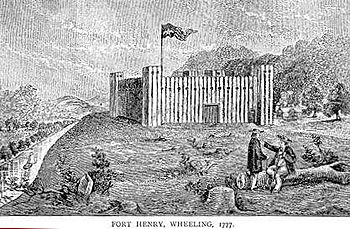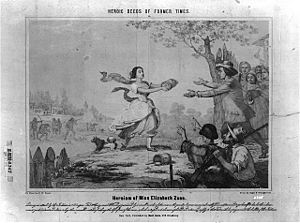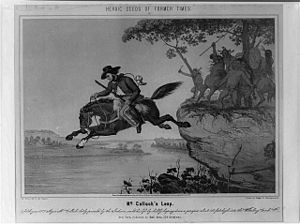Fort Henry (West Virginia) facts for kids
Quick facts for kids Fort Henry (Fort Fincastle) |
|
|---|---|
| Wheeling, West Virginia | |
 |
|
| Type | stockade |
| Site information | |
| Controlled by | Colony of Virginia and Virginia |
| Site history | |
| Built | 1774 |
| In use | 1774–1784 |
| Battles/wars | Lord Dunmore's War American Revolutionary War
|
Fort Henry was an important old fort built a long time ago. It stood near the Ohio River in what is now Wheeling, West Virginia. The fort was first called Fort Fincastle. It was named after Viscount Fincastle, who was the Royal Governor of Virginia. Later, its name changed to Fort Henry, honoring Patrick Henry, a famous American leader. This fort was very important during two big battles and other smaller fights. Two brave acts happened here: McColloch's Leap and Betty Zane's daring trip.
Contents
History of Fort Henry
Fort Henry was built in June 1774. It was one of many forts made to protect settlers on the edge of the American colonies. These forts were built in the mid-1770s. The main reason for building Fort Henry was the start of Lord Dunmore's War. This was a conflict between Native American tribes from the Ohio Country and settlers from Virginia.
Colonel William Crawford oversaw the building of the fort. He was following orders from the Royal Governor of Virginia, Lord Dunmore. People living in the area and military leaders at Fort Pitt (Pennsylvania) both realized a fort was needed. John Connolly wrote to the settlers in Wheeling, telling them to build defenses quickly.
Ebenezer Zane and John Caldwell started building the fort. Captain William Crawford, Colonel Angus McDonald, and 400 soldiers from Fort Pitt helped them finish it. Lord Dunmore approved of the fort being built at Wheeling.
How the Fort Was Built
The fort covered about half an acre of land. It was naturally protected on three sides by the land itself. On the south and west sides, a steep hill (called a bluff) made attacks very hard. To the north, a deep ditch (a ravine) also offered protection. The only flat way to enter the fort was from the east.
A small, strong building called Zane's blockhouse protected the main entrance. Attackers trying to get in would have to pass by it. This meant they would be caught between gunfire from the fort and the blockhouse. All recorded attacks on Fort Henry came from the east side.
The outer wall of the fort was a palisade. This means it was made of tall, strong timbers (logs) standing upright. There were also strong blockhouses at each of the four corners. In 1781, a two-story log building was added near the front gate. A cannon was placed on top of this new building.

Fort Henry in the American Revolutionary War
Fort Henry was attacked twice during the American Revolutionary War. The first attack happened in 1777, and the second was in 1782.
First Battle of Fort Henry (1777)
In 1777, Native American warriors from the Shawnee, Wyandot, and Mingo tribes joined together. They attacked settlements along the Ohio River. Local men, along with soldiers from other nearby forts, defended Fort Henry. The attacking force later burned the cabins and destroyed farm animals around the fort.
Major Samuel McColloch led a small group of men to help Fort Henry. McColloch became separated from his men and was chased by attacking Native Americans. On his horse, McColloch rode up Wheeling Hill. Then, he made a famous jump, known as McColloch's Leap. He jumped about 300 feet down the eastern side of the hill to safety. The attackers rushed to the edge, expecting to see him dead. But to their surprise, they saw McColloch still on his white horse, galloping away from them.
Second Battle of Fort Henry (1782)
In 1782, a group of Native American warriors and some British soldiers tried to capture Fort Henry. During this attack, the fort ran out of ammunition. The defenders decided to send someone to get more ammunition from the nearby Zane homestead. Betty Zane bravely volunteered for this dangerous job.
As she ran out of the fort, both Native American and British soldiers shouted at her. She successfully reached the Zane homestead. There, she gathered a tablecloth and filled it with gunpowder. As she ran back to the fort, she was shot at, but she was not hurt. It is believed that one bullet did go through her clothes. Because of Betty Zane's brave act, Fort Henry remained under American control. Many other small fights also happened near the fort.


